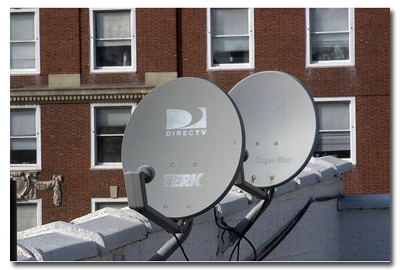|
|
 |
Knowledge Is Key
For Intelligent Decisions
Satellite Logic is a leading,
authoritative source of information in
the Satellite Industry. Located in the
heart of the Silicon Valley, Satellite
Logic provides one of the most
valuable and comprehensive
knowledge bases on the Satellite
market! This is a primary Worldwide
information center which enables our
clients to analyze, evaluate, inquire
and select their best tailored
solutions. Our company sets the
industry standards for targeted
buying leads, reflecting a dramatic
advance over traditional marketing
solutions.
|
|
|
 |

With DIRECTV you can count on receiving a professional installation
service from a highly trained team that will mount, align and peak your
dish on your roof, balcony or any other suitable location.
The professional installer will use only DIRECTV approved materials,
including RG-6 cable, switches and connectors. He will connect your
receiver(s) to your TV and DVR, VCR or DVD player. The installer will also
connect your receiver(s) to a phone line in your home and will ground
your system to meet local/NEC requirements.
The installation process includes personal guiding on how to operate the
system. You'll be shown how easy it is to use your system and the
DIRECTV services. The installer will set a satellite dish on your roof,
balcony or other location, connecting your receiver to your TV.
You don't need to own a house to enjoy DIRECTV service. Our
professional installers will mount the DIRECTV satellite in the most
appealing location for your home, apartment, condominium or
townhouse. You may need to ask permission from a landlord if the
house is not yours, before getting a DIRECTV System installed.
Prior to the installation process you'll have to pick the room(s) where
you'd like to watch DIRECTV programming. Move your television away
from the wall to help the installer reach the connections. For the entire
process set aside 2 to 4 hours to be at home so the installer has time
to connect your system and give you a simple demonstration. Make sure
someone over 18 is home to sign the installation documents when the
installer is finished.

Another thing you'll have to do is to clear roof access. Make sure your
roof or balcony has easy access for the installer. Also, make sure you
have a land-based phone connection with a nearby jack (or wireless
jack) so you can take advantage of great features like On-Screen Caller
ID and ordering Pay Per View. You'll need caller ID service from your
phone service provider.
If you live in an apartment or are part of a homeowners' association,
check with your landlord or management company about regulations for
installing television service. You may need to fill out a Landlord
Permission Form.
In some cases you may want to do it yourself, using the free installation
kit. After all, it is only 18 inches and not at all heavy. Or we can arrange
for a professional to do it for you.
Before you start you will need to know which way to point the dish.
Obviously it will be facing the southern sky. A couple of terms you will
need to know are azimuth and elevation. The azimuth is the direction
from east to west that the satellite is from your home. It will be read on
your compass in degrees. The elevation is how far above the horizon
the satellite is. The azimuth and elevation will be different depending on
where you live. You may use the company's tables to find the azimuth
and elevation from some major US cities. The RCA and Sony receivers
have on-screen satellite locators if your city is not listed.
You can put the dish on your roof, on the side of your house, on the
chimney, on a pole in the ground, or any other place that has a view of
the satellite. The dish can also be mounted inside looking out a window
if the window does not contain too much lead. If you are installing in the
winter, make sure you will still have a view of the satellite when the
trees have leaves.
Using a compass, point the dish close to where the satellite should be.
The signal strength meter in the receiver will show you how to find the
signal. The difference between a good and bad signal is not the quality
of the picture, but whether you will experience the loss of picture
because of rain.
If you're not able to acquire a signal you can send the system back. In
most cases, there is some location on your property where you'll be able
to acquire the DirecTV signal.
If you want to order Direct Ticket Pay Per View by remote, if you have
more than one receiver, or if you want to get certain sports
programming, you will need to have the receiver connected to a phone
line. The receiver has a modem which calls out on a regular phone line.
It will not interfere with your use of the phone.
That's it, not very complicated.
|
|
|
|
